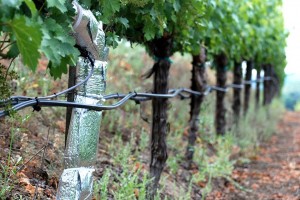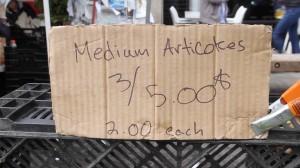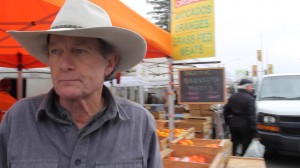
Ten months ago, Napa winemaker Elias Fernandez monitored his vines the old-fashioned way: going into the fields and checking on them once a week.
Today, Fernandez receives a text message on his iPhone alerting him if certain sensor-equipped vines aren’t getting enough water. Using color-coded software on his computer, he monitors weather, atmosphere, humidity and wind speed.
“In the old days you would look at a vine and say, ‘Yeah, it looks like it needs water,’ and 60 percent of the time those decisions were probably the wrong thing to do,” said Fernandez of Shafer Vineyards, which is in Yountville, Calif., an hour north of San Francisco. “Today, with this, you can actually get into what the vine is sensing.”
Thanks to the monitoring devices supplied by Oakland-based Fruition Sciences, Shafer Vineyards says it has saved more than 160,000 gallons of water in the past year.
Dana Estates and Silver Oak Winery have also started using the sensor-software combo to keep an eye on their vines. Cameron Vawter, the director of winemaking at Dana Estates, says he has saved more than 2.5 million gallons of water annually across all three of Dana’s vineyards since adapting Fruition Sciences’ technology in 2006.
Fruition Sciences’ sensors can also apply to other crops, such as tomatoes and avocados. The company says the tech is in trials in perennial crop fields throughout the state.
For some forward-thinking winemakers and other early adopters, the jump-start on these methods couldn’t have been more auspicious, as California suffers from a historic drought that is leaving farms parched and fallowed. But the water saved in these cases is still a drop in the bucket compared with the greater water needs of the state. California supplies over a third of the country’s vegetables and nearly two-thirds of the country’s fruits and nuts, according to the state’s department of food and agriculture. And the vast majority of the state’s water goes to agriculture.

There are also barriers to widespread adoption. It is unclear how effective newer technology can be on a wide scale, making some farmers reluctant to experiment with new equipment while near-future crop yields look uncertain. Investment in water-conservation tech is still relatively small, with less than one percent of all venture capital going into the sector, according to Scott Bryan, the chief operating officer of a San Francisco nonprofit called Imagine H2O.
And then, of course, there’s cost. Fruition Sciences charges $50 per “smart point,” with farmers selectively applying the sensors to certain vines. Elias Fernandez of Shafer Vineyards says the technology is costing him around $20,000 a year.
“The margins can be so slim in agriculture and investing in equipment can be a relatively tall task,” Bryan said.
Bryan’s organization, Imagine H2O, looks to bolster new water-conservation technologies through an annual business competition. Its winner in 2011 — Union City-based mOasis — just began shipping its product.
Unlike Fruition Sciences’ vine sensors, crop-science startup mOasis is tackling water conservation at the roots –- literally. The company has created a gel that absorbs excess water in soil at the time of planting, and then re-releases the water as the soil dries out.
The product, called Aquamer, costs farmers $150 per acre and is targeted at California staple crops like tomatoes, lettuce, broccoli and tomatoes. During trials, it was used by about a dozen farmers on the western side of the Central Valley. mOasis claims its technology can reduce water usage by more than 20 percent and create 25 percent higher crop yields by maximizing the soil’s water retention and putting less stress on crops.
“There’s a lot of interest in the product right now, and there has been even since before the drought,” said mOasis CEO Steve Hartmeier. Still, he recognizes that his product alone can’t solve California’s water woes.
“I think California is going to be in a drought for the next 15 years,” he said. “We still have to develop a program that addresses long-term supply issues in the state.”
Strawberry grower Apolinar Yerena runs a family strawberry farm in Watsonville, Calif., just south of Santa Cruz along the Pacific Coast. He says he’s aware of instruments that can help control or monitor moisture in soil, but doesn’t use them.
“We haven’t used any new methods, any new technologies,” since the drought became a state of emergency, he said. “We’re a small farm … But now, I think we have to consider it.”

Bob Blanchard raises grass-fed cattle for slaughter, goats and lamb, as well as Valencia oranges and Haas avocados at Old Creek Ranch in Cayucos, Calif., in the San Luis Obispo valley. At a recent Sunday Farmers’ Market in Palo Alto, he lamented the toll the water shortage is taking on farmers like him.
Drip irrigation machines and mini-sprinklers — technology that has been available for decades — are helping him grow his fruit. The trouble has been finding enough water to grow grass to feed his livestock.
“Over the twelve months, we’ve had to reduce our livestock inventory by fifty percent,” Blanchard said.
While recent storms buoyed the hopes of many farmers in the Central Valley and northern part of the state, the drought still persists. Last year was reported to be the driest year on record in California, and in January, Gov. Jerry Brown declared the drought to be a state of emergency. In Northern California, some rural communities are potentially facing a shortage of drinking water, while hundreds of thousands of acres of farmland are fallow.
In mid-February, President Barack Obama visited parts of California’s drought-stricken areas and pledged up to $100 million in aid to farmers who had lost their livestock due to the drought. Obama also allocated $15 million to help farmers with water conservation methods.
To incentivize prudent water use, the U.S. Department of Agriculture is awarding $20 million in grants for California growers actively conserving water.
But shortly after Obama’s visit, U.S. officials said that Central Valley farmers wouldn’t be receiving any irrigation water from the federal government this year, because of a lack of runoff water in the Sierra Nevada.
Jay Famiglietti, a professor of earth sciences at University of California, Irvine, and a leading hydrology expert, says there seem to be “promising advances” in water conservation solutions, and that it’s a good thing that emergency funding has been identified.
Ultimately, though, drought problems are “not going to go away,” he said. “So we need short-term plans, and long-term ones.”
